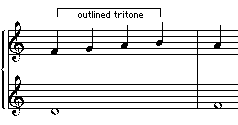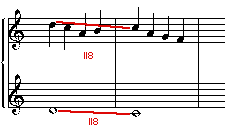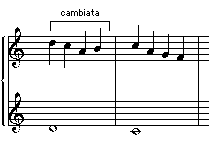 (Modified from first species) No voice should make a leap larger than a fifth, except for the octave. Motion is too quick in Third Species to allow the minor sixth leap.
(Modified from first species) No voice should make a leap larger than a fifth, except for the octave. Motion is too quick in Third Species to allow the minor sixth leap.
In Third Species counterpoint one part moves in rhythmic values that in a duple meter are one fourth the value of the cantus firmus notes (in a triple meter third species runs six accompaniment notes to each one of the c.f.). If there are more than two voices, one voice has the shorter note values while the others move together as in First Species:

 (Modified from first species) No voice should make a leap larger than a fifth, except for the octave. Motion is too quick in Third Species to allow the minor sixth leap.
(Modified from first species) No voice should make a leap larger than a fifth, except for the octave. Motion is too quick in Third Species to allow the minor sixth leap.
 (As in first species) Avoid making successive same-direction leaps in the same voice unless they outline a triad. If they can't be avoided they should at least total less than an octave.
(As in first species) Avoid making successive same-direction leaps in the same voice unless they outline a triad. If they can't be avoided they should at least total less than an octave.
 (As in first species) Leaps greater than a fifth should be compensated by stepwise movement in the opposite direction.
(As in first species) Leaps greater than a fifth should be compensated by stepwise movement in the opposite direction.
 (As in first species) No voice should move by a chromatic interval (any augmented or diminished interval).
(As in first species) No voice should move by a chromatic interval (any augmented or diminished interval).
 (As in first species) Avoid repeating a pitch in the lowest voice. In upper parts you can repeat a pitch as many as three times successively if necessary.
(As in first species) Avoid repeating a pitch in the lowest voice. In upper parts you can repeat a pitch as many as three times successively if necessary.
 (As in first species) Keep each voice confined to a singable range for the part, preferably not exceeding a 10th from its highest to its lowest pitch.
(As in first species) Keep each voice confined to a singable range for the part, preferably not exceeding a 10th from its highest to its lowest pitch.
 (As in second species) Avoid writing the same melodic interval twice on the same pitches.
(As in second species) Avoid writing the same melodic interval twice on the same pitches.
 (New) You should take care not to outline a tritone in melody. A tritone is outlined if the melodic line changes direction at the notes that form it:
(New) You should take care not to outline a tritone in melody. A tritone is outlined if the melodic line changes direction at the notes that form it:

 (New) One voice has four notes to each note of the cantus firmus, or in ternary meter it has six. If there are additional voices, they move with the cantus firmus as in first species.
(New) One voice has four notes to each note of the cantus firmus, or in ternary meter it has six. If there are additional voices, they move with the cantus firmus as in first species.
 (As in second species) In both binary and ternary meter you may occasionally substitute a rest for the first note of each group (that is, the one that coincides with the cantus firmus).
(As in second species) In both binary and ternary meter you may occasionally substitute a rest for the first note of each group (that is, the one that coincides with the cantus firmus).
 (As in second species) The faster voice should begin after the cantus firmus, following a rest. The parts will still end together and can use the same note value for the final sonority. In three or more parts only one voice will be moving faster than the others; the others can still enter together.
(As in second species) The faster voice should begin after the cantus firmus, following a rest. The parts will still end together and can use the same note value for the final sonority. In three or more parts only one voice will be moving faster than the others; the others can still enter together.
 (As in first species) Avoid writing parallel fifths or octaves (moving two voices in the same direction from one fifth or octave to another).
(As in first species) Avoid writing parallel fifths or octaves (moving two voices in the same direction from one fifth or octave to another).
 (New) Some authorities believe you should avoid parallel perfect intervals between prominent notes of each measure, particularly between the first notes of successive measures. Fux's examples do include at least two instances of such parallels, but since the opinion of other writers (Victor Lytle says "all authorities" p. 54) is united against this practice we should observe the rule. Avoid parallel perfect intervals between prominent notes of each measure, as displayed in this example from Fux:
(New) Some authorities believe you should avoid parallel perfect intervals between prominent notes of each measure, particularly between the first notes of successive measures. Fux's examples do include at least two instances of such parallels, but since the opinion of other writers (Victor Lytle says "all authorities" p. 54) is united against this practice we should observe the rule. Avoid parallel perfect intervals between prominent notes of each measure, as displayed in this example from Fux:

 (As in first species) Avoid writing direct fifths or octaves (moving two voices in the same direction to a fifth or an octave). There are exceptions: these may be acceptable at a cadence, or if one voice is inner and the exposed voice moves stepwise. Direct 5ths in the outer voices will be accepted if the upper voice moves by step.
(As in first species) Avoid writing direct fifths or octaves (moving two voices in the same direction to a fifth or an octave). There are exceptions: these may be acceptable at a cadence, or if one voice is inner and the exposed voice moves stepwise. Direct 5ths in the outer voices will be accepted if the upper voice moves by step.
 (As in first species) Do not let two voices leap to a perfect interval unless one of them is an inner part.
(As in first species) Do not let two voices leap to a perfect interval unless one of them is an inner part.
 (As in first species) One perfect interval can follow another in the same voices only if one of the voices moves stepwise.
(As in first species) One perfect interval can follow another in the same voices only if one of the voices moves stepwise.
 (As in first species) Avoid parallel fourths unless the lower tone of the fourth is not the bass and the pitch class a third below that note is present (that is, parallel 1st-inversion triads are OK). Fourths can also be allowed if one of the tones is nonessential.
(As in first species) Avoid parallel fourths unless the lower tone of the fourth is not the bass and the pitch class a third below that note is present (that is, parallel 1st-inversion triads are OK). Fourths can also be allowed if one of the tones is nonessential.
 (As in first species) Upper voices can sometimes cross if necessary, but avoid "overlapping" (in an overlap voices do not cross, but one moves to a position that is at or beyond the previous pitch of another voice).
(As in first species) Upper voices can sometimes cross if necessary, but avoid "overlapping" (in an overlap voices do not cross, but one moves to a position that is at or beyond the previous pitch of another voice).
 (As in first species) Avoid writing more than three of the same interval in a row in any two parts (e.g. four consecutive thirds or four consecutive sixths).
(As in first species) Avoid writing more than three of the same interval in a row in any two parts (e.g. four consecutive thirds or four consecutive sixths).
 (As in first species) In all species of counterpoint, use contrary motion frequently to emphasize the independence of voices.
(As in first species) In all species of counterpoint, use contrary motion frequently to emphasize the independence of voices.
 (New) Unlike First and Second Species, unisons are now permitted within the composition (not just at the beginning and end), except on the first note of a measure.
(New) Unlike First and Second Species, unisons are now permitted within the composition (not just at the beginning and end), except on the first note of a measure.
 (Modified from second species) The first note in each group must be consonant. Fux (Alfred Mann, p.50) allows the third note to be dissonant if the 2nd and 4th notes are consonant, and we will follow Fux for this exercise. You should be aware, however, that Jeppeson (p. 143) says with his considerable authority that a dissonant third note in a group of four is entirely inappropriate in the style of Palestrina. If you would like to observe that more strict rule in personal study just turn on the "no accented dissonances" option.
(Modified from second species) The first note in each group must be consonant. Fux (Alfred Mann, p.50) allows the third note to be dissonant if the 2nd and 4th notes are consonant, and we will follow Fux for this exercise. You should be aware, however, that Jeppeson (p. 143) says with his considerable authority that a dissonant third note in a group of four is entirely inappropriate in the style of Palestrina. If you would like to observe that more strict rule in personal study just turn on the "no accented dissonances" option.
 (New) Dissonances must be approached and left by step, with the exception of the figure known as the Cambiata (or "changing tone"). If you were observing Palestrina's stricter style, as per Jeppeson's above note, the Cambiata would need to be one in which only the second note was dissonant.
(New) Dissonances must be approached and left by step, with the exception of the figure known as the Cambiata (or "changing tone"). If you were observing Palestrina's stricter style, as per Jeppeson's above note, the Cambiata would need to be one in which only the second note was dissonant.

 (As in first species) If in two parts the music must begin with perfect consonances (octaves, fifths, or unisons) and end with octaves or unisons. In three or more parts you can begin and end with full triads, but the ending must be either a major triad or a perfect consonance. Fux advises that if the mode does not contain a major third over the tonic, then it is best to leave the third out of the final chord rather than to raise it to a major third.
(As in first species) If in two parts the music must begin with perfect consonances (octaves, fifths, or unisons) and end with octaves or unisons. In three or more parts you can begin and end with full triads, but the ending must be either a major triad or a perfect consonance. Fux advises that if the mode does not contain a major third over the tonic, then it is best to leave the third out of the final chord rather than to raise it to a major third.
 (As in first species) The cantus firmus will always begin and end with the tonic. If the cantus firmus is in an upper voice be sure not to harmonize it with a fifth below at the beginning. That would give the impression of a different mode.
(As in first species) The cantus firmus will always begin and end with the tonic. If the cantus firmus is in an upper voice be sure not to harmonize it with a fifth below at the beginning. That would give the impression of a different mode.
 (As in first species) Avoid doubling a seventh.
(As in first species) Avoid doubling a seventh.
 (As in first species) Avoid placing the chromatically altered form of a note immediately adjacent to its unaltered form in a different voice (i.e. cross relation).
(As in first species) Avoid placing the chromatically altered form of a note immediately adjacent to its unaltered form in a different voice (i.e. cross relation).
 (As in first species) In two-part writing, avoid adjacent use in different voices of two pitches that form the tritone (tritone cross relation).
(As in first species) In two-part writing, avoid adjacent use in different voices of two pitches that form the tritone (tritone cross relation).
 (As in first species) In general keep to the pitch classes of the mode expressed by the cantus firmus. Unless you transpose a cantus firmus this will in practice mean the "white key" notes in Counterpointer's species exercises. Nonmodal tones may be introduced, however, if they accord with conventional principles for altered tones.
(As in first species) In general keep to the pitch classes of the mode expressed by the cantus firmus. Unless you transpose a cantus firmus this will in practice mean the "white key" notes in Counterpointer's species exercises. Nonmodal tones may be introduced, however, if they accord with conventional principles for altered tones.
©2009 Ars Nova Software, LLC